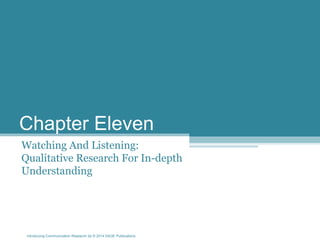More Related Content
Similar to 17352 11ppt (20)
17352 11ppt
- 2. Key Concepts
• Primary interest is in people’s subjectivity.
• Emphasis on capturing participant viewpoints.
• Reporting often uses participant’s language.
• Qualitative more than quantitative.
• Theories about human communication may
emerge from research rather than being a
starting point.
Introducing Communication Research 2e © 2014 SAGE Publications
- 3. Observational Methods
Advantages & Disadvantages
Advantages Disadvantages
In-depth exploration of attitudes and
behavior.
May be difficult to access
participants.
Validity. Reliability.
Access to participants’ views of
phenomena.
Research outcomes affected by
researcher-participant relationships.
Provide insight and explanation. May be time-consuming.
Introducing Communication Research 2e © 2014 SAGE Publications
- 4. Qualitative & Quantitative Research
• Similarities
▫ Begin with qualitative observations
▫ Emphasis on precise reporting.
• Differences
▫ Qualitative: reporting in words, understanding
in depth, emphasis on participant perspectives,
judgmental sampling.
▫ Quantitative: reporting in numbers,
understanding in breadth, statistical sampling,
generalizing from samples.
Introducing Communication Research 2e © 2014 SAGE Publications
- 5. Watching and Listening Methods
• Interviews
• Focus groups
• Ethnography
• Observational studies
• Unobtrusive measures
• Conversation analysis
• Case studies
Introducing Communication Research 2e © 2014 SAGE Publications
- 6. Observational Methods:
Basic Assumptions
• Individuality and subjectivity of each
participant is important.
• Participants are assumed to have insights and
perspectives the researcher is unaware of.
• Interpretation and meaning are more
important than information.
Introducing Communication Research 2e © 2014 SAGE Publications
- 7. Ethnography: Key Ideas
• Focus on meaning and interpretation.
• Conduct research in participants’ own
settings.
• Engage directly with participants.
• Focus on local, individual, subjective
knowledge.
• Record participants’ own language, concepts
and logic.
• Report results as detailed description.
Introducing Communication Research 2e © 2014 SAGE Publications
- 9. Terminology
• Participant
▫ volunteer in a research project.
• Informant
▫ can speak about others as well as themselves.
• Respondent
▫ speaks only for himself or herself.
• Interviewee
▫ anyone interviewed.
• Subject
▫ participant in experimental research.
Introducing Communication Research 2e © 2014 SAGE Publications
- 10. Interview
A series of questions designed to elicit
information a researcher is interested in.
Questions may be –
• Predetermined and specific
▫ for example, a survey questionnaire
or
• Flexible and open-ended
▫ for example, “Tell me about . . .?”
Introducing Communication Research 2e © 2014 SAGE Publications
- 11. Interview: Strategy & Decisions
Strategy:
▫ Generally a “master” question and then specific
questions to “check it out.”
Decisions:
▫ Setting
▫ Sensitivities
▫ Structure
▫ Sequence
Introducing Communication Research 2e © 2014 SAGE Publications
- 12. Interview: Decisions - cont.
Setting
▫ Participants’ or researcher’s location.
Sensitivities
▫ Dress, language, gender, status.
Structure
▫ Fully, partially, or unstructured.
Sequence
▫ Funnel or inverted funnel.
Introducing Communication Research 2e © 2014 SAGE Publications
- 13. Interview: Types of Questions
• Descriptive
▫ Ask participants to describe.
e.g. “What is a typical ____ like, for you?
• Structural
▫ Ask participants to explain relationships.
e.g. Would you describe X as part of Y?
• Contrast
▫ Ask participants to describe similarities, differences or
relative importance.
e.g. “What is the difference between X and Y?
Introducing Communication Research 2e © 2014 SAGE Publications
- 14. Focus Group: Assumptions
Group discussion can generate -
More information than interviewing individuals.
Different information than interviewing
individuals
A “2+2 = 5” effect
Ideas the researcher may not have considered.
Introducing Communication Research 2e © 2014 SAGE Publications
- 15. Focus Group: Success
• Members - recruited for similar knowledge but
divergent views of the topic.
• Objectives - clear.
• Atmosphere - relaxed.
• Discussion - free-wheeling.
• Moderator:
▫ listens
▫ maintains focus
▫ refrains from discussion
▫ ensures every member participates.
Introducing Communication Research 2e © 2014 SAGE Publications
- 16. Analyzing Qualitative Data
Most analyses use categorization.
• Fixed Coding
▫ Assigns units of information to
theoretically-determined categories.
• Flexible Coding
▫ Allows additional categories to emerge
during analysis.
Introducing Communication Research 2e © 2014 SAGE Publications
- 17. Analyzing Qualitative Data – cont.
The Grounded Theory Approach –
• Assumes theory will emerge as data analysis
proceeds.
• Uses the “constant comparative method.”
▫ Test each new statement or idea against initial
categories.
▫ Rework categories as data analysis proceeds.
Introducing Communication Research 2e © 2014 SAGE Publications
- 18. Unobtrusive Measures
Observing people without them being aware
of the observation.
• Why?
▫ To assess differences between what people tell us and
what they actually do.
• Examples –
▫ Observing crowd behavior at sports events.
▫ Observing social behavior at parties.
▫ Observing group problem solving.
Introducing Communication Research 2e © 2014 SAGE Publications
- 19. Conversation Analysis
• Studies the processes that enable people to
converse successfully.
• Analyzes transcripts of conversations to
determine how people negotiate
understanding.
• Focuses on social acts more than language.
Introducing Communication Research 2e © 2014 SAGE Publications
- 20. Case Study
Brings all relevant information into a story to help
readers learn how organizations or individuals
managed a project, problem or crisis.
Usually –
• uses multiple sources of evidence
• focuses on a specific issue
• provides in-depth understanding more than
generalization or prediction.
Introducing Communication Research 2e © 2014 SAGE Publications
- 21. Chapter Summary
Watching and Listening Methods –
• General interest in people’s idiosyncratic,
subjective views.
• Begin with theory, or allow theory to emerge.
• Preference for eliciting people’s views in their
own words.
• Typically reported in participants’ language.
• Observation provides a check on whether
people’s words match their behavior.
Introducing Communication Research 2e © 2014 SAGE Publications
- 23. Web Resources
• Forum: Qualitative Social Research -
http://www.qualitative-research.net/index.php/fqs
• Qualitative Research Consultants Association
http://www.qrca.org
• University of Surrey, social research update -
http://sru.soc.surrey.ac.uk/
Introducing Communication Research 2e © 2014 SAGE Publications
